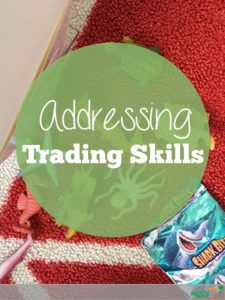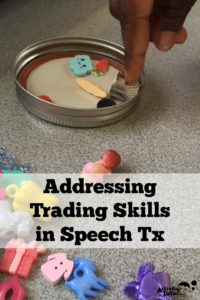Have you watched kids interacting in real life? They are in a constant state of negotiation. They make deals about who will go first, who gets to be which role, who does which chore. They trade snacks, lunches, cards and little treasures.
It’s a really sophisticated skill.
And it requires a lot of social acumen and language ability—two areas our kids are often lacking in. It’s a good thing to work on so that they aren’t taken advantage of, but also so they don’t bully their way into getting what they want either.
This year I bought a big bag of plastic sea creature figures and divided them into little take out containers as end-of-the-year gifts. During our last session, I let the kids open their box, look over their miniatures and trade with others in the group.
One of my students who struggles with social skills is seen in an articulation group. He took one look inside his box and said “I’m good,” closed it back up and effectively closed the conversation. It wasn’t because he had every creature he wanted, it was because experience had taught him that he’d be likely to get the short end of the stick in a negotiation.
You can simply have students trade and support appropriate requests/responses or you can explicitly teach what a negotiation is.
- Negotiation means “give and take” which means we need to prioritize what we are willing to both give and what we want to keep.
- Both parties should feel like they got a good deal.
- Equal value doesn’t always mean even numbers. If one person has a highly sought after trading card, they might need 2-3 cards of lesser value to equal the “cost.”
- Listening is a critical negotiating skill. What is the other person valuing most? What are they willing to give up?
Want to set up practice scenarios?
- Bring one fancy chair to your room and help kiddos negotiate who sits in and what they give up in return (ex. the other student goes first or gets an extra sticker)
- If you have a box of miniatures (and you should!) give each student five before the session starts and let them trade for a few minutes before formal therapy begins. The miniatures can just sit on their desk for the session and be returned at the end.
- Set students up, each with a small pile of Legos. Each pile of Legos should contain similar sized (or colored) Legos and be different from the other students. (ex. one student only has 4 dot squares, another has long single dot bricks, another just has unusual shapes. Encourage them to trade for the bricks they need.
- Tip: Use lids or small containers to keep items they designate “not trade” organized from others.
Want to save this post? Pin the image below!
Today is the final SLP Must Have Sale for the 2018-19 school year! Head to TPT and search #Jun2018SLPMustHave for a listing of all products that are 50% off. You’ll find my popular Articulation Paper Chains that can be used year round and have both single word picture prompts or sentences.








This Post Has 2 Comments
Great ideas! If we have a disagreement over which game to play on a “free choice” day, I have the kids agree on a strategy (pick a number 1-10, roll dice, rock/paper/scissors, etc.) to decide whose pick we go with. I typically say the other child (whose choice “lost”) gets to go first, but maybe I’ll introduce that option upfront and let the kids do more negotiation. It’s so tricky to balance providing those opportunities and making sure we have enough time for the rest of our tasks, but I appreciate the reminder of how critical these skills are.
If you are interested in a text to tie in with some of these skills, “A Bargain for Frances” by Russell Hoban might be a good choice to introduce the topic!
I really like the ideas on ways to practice the scenarios for having the kids negotiate, I find so many have trouble with this skill. Thanks so much!
Comments are closed.